Commuting by bicycle has many variants. City dwellers hop on a ride, avoiding underground systems or busy walkways. In the suburbs, new cycling infrastructure might open safer routes which include dropping kids off or stopping for a coffee. There is also a place for longer-distance commutes.
Long-Distance Bike Commuting
As many developed countries’ authorities begin to incorporate longer, safer and more connected routes that encourage cycling via segregated lanes or away from vehicles via shared ways, we can see an increased number of options to bring more riders out onto the roads from longer distances than ever before.
Choosing a route for a longer distance commute needs to take in considerations such as the distance of a commute (covered here), riding surfaces, infrastructure and safety, lighting conditions in winter, proximity of public transportation, and emergency facilities like a bike shop.
Once you’ve looked into these (forums or apps like Komoot or Strava are great for identifying commonly used routes by sharing user data) you can then add probably the most important part of the jigsaw; the bike. Most of the biggest brands in the world now offer models for any type of riding, as we examine here.
Best Long Distance Commuter Bikes
1. Road Bikes
Road bikes are pedigree machines with the principal aim of being ridden quickly. To ride quickly you need to be aerodynamic and light. These models are designed in order to cheat the wind and they can do this by creating a riding position which reduces your ‘drag’ but can be uncomfortable over long distances if you’re not wearing specific kit.
Manufacturers have invested a lot in shaping the frame to assist the aerodynamics and also apply components which are light and reliable. Tyre width and the tucked in, cramped riding position mean shifting around a bit more while sat on the saddle. If you commit to a road bike, your commute will be the quickest but probably the most ‘skittish’ and tense.
You will most likely follow the arteries and veins of other vehicles’ journeys if you choose a road bike. You will be jostling with other road users more frequently. The average speed that a cyclist on a road bike can maintain might mean that you will keep up with, or need to pass, other road users. Road bikes are not the easiest to move around on when riding slowly – the turning front wheel is closer to your foot during the pedalling motion than almost any other type.
Commuting on a road bike is covered in more detail here. The routes you can take because of the riding surfaces and to some extent, the infrastructure can influence the fulfilment of a journey. Of course, you can ride in a traditional upright position but that is not what the road bike is intended for. They can vibrate quite a lot and the frames and riding position are ‘stiff’. You perhaps need to train and condition yourself more when learning or mastering a road bike than most others.
Road Bikes for Long-Distance Bike Commuting [PROS + CONS]
| PROS | CONS |
|---|---|
| Speed | Often a rigid ride – unforgiving |
| Weight means less effort to ride | Limited carrying points or mounts for mudguards / fenders |
| Road bikes are pretty low maintenance | Only truly compatible with asphalt surfaces |
Best Road Bikes for Long Distance Bike Commutes

The Domane range from Trek is packaged to offer a more comfortable riding experience than most other road bikes. The position is less formal and rigid. A longer-distance commute should be easier to manage.
Both handling and comfort are considered with a more relaxed frame geometry and curved forks – this also dampens the vibrations too. It comes with plenty of mounts and fittings for racks and mudguards / fenders.
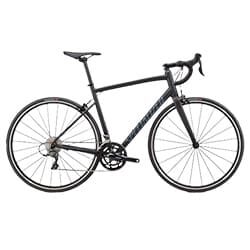
The Specialized Allez is a machine with over 50 years of research and development behind it. The gender neutral frame design is relaxed which reduces aches and pains and light frame tubing are ideal for long commutes.
A carbon fibre fork reduces vibration from road buzz which makes longer distance rides more tolerable. The component parts are tried and tested and there are integrated mounts for mudguards and racks.
2. Touring Bikes
Touring bikes are a great solution for long-distance commuting. They are incredibly functional machines – never in fashion or subject to trends and built as workhorse modes of transport. Their essential design incorporates loads of luggage carrying potential. This lowers the centre of gravity and also gives a very relaxed riding position for riding day in day out.
You will naturally be drawn to a more upright position which is more comfortable and allows for more visibility – both for you and of you – which is obviously safer. Then there is the option of a butterfly handlebar which are more comfortable for some riders even than the flat bar of a hybrid. Touring bikes are really suited to road and light gravel terrains – canal towpaths and shared ways are ideal but off road hills are going to be difficult.
A really important feature is the reliability. The brakes are very strong as they are intended to carry more weight than most other models and there is the potential for wider tyres too. You get the balance of a road bike and gravel bike which tops up the number of possible routes you can consider with your commute – towpaths and the converted old railway lines that go into urban areas will be a cinch.
Touring Bikes for Long-Distance Bike Commuting [PROS + CONS]
| PROS | CONS |
|---|---|
| Easier geometry makes for a comfortable ride | Heavy |
| Some have carrying accessories included | A bit limited in their scope to do other things apart from commuting and touring |
| Great gearing for when you need it | Handling might not be as responsive as you need |
Best Touring Bikes for Long Distance Bike Commutes
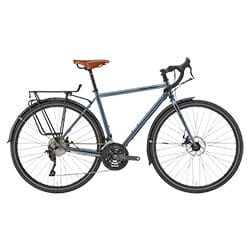
This bike is packed with features which are really useful for long-distance commuters. There are plenty of gears and gear-shifters handily placed at the end of the handlebars.
Kona frames are considered to be some of the smoothest around but our favourite feature has to be the Brooks leather saddle. Good components for the price too.
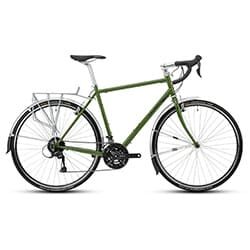
A bombproof traditional steel touring model harking back to frame building techniques founded at a time where cycling commuting and touring was a way of life. It uses Reynolds steel which is a benchmark for reliability.
A great frame and fork is supported by a Shimano groupset and full length mudguards and a rear rack. This is a really elegant machine to support commuting as a mode of transport which might earn more space and respect on the roads.
3. Gravel Bikes
You’ll need to do a double-take to spot the differences between a road bike and gravel bike at first glance. However, the subtle changes are really helpful in reducing or eliminating some of the challenges of using a road bike for a long-distance commute.
Gravel bikes are so comfortable. Because they are designed for durability over sketchy surfaces, when you transfer that set-up to the road, you get a buttery ride. The geometry sits between a mountain bike and road bike which means balanced control and comfort. Gravel can handle most surfaces easily apart from deep, wet mud.
The tyre clearance means softer rides too and wider tyres can be inflated to lower pressures without ticking off all of your speed. You can also choose a tread that combines road and gravel capabilities. Have a look at gravel bikes v road bikes here.
Perhaps the best aspect for a longer commute is their versatility – you can accessorise if you need to carry luggage, they all suit mudguards / fenders, the gearing is wide ranging for most commuters and you really can take them everywhere a commute might expect you to take.
Gravel Bikes for Long-Distance Bike Commuting [PROS + CONS]
| PROS | CONS |
|---|---|
| Relaxed geometry without forgetting aerodynamics entirely | A little heaver than a road bike |
| So versatile for all commuting needs and expectations | Stock wheels can underwhelm |
| Robust for tacking the urban environment | Bit more expensive than road bikes pound for pound |
Best Gravel Bikes for Long Distance Bike Commutes
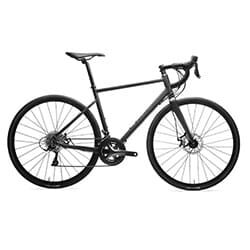
This is a straightforward introduction to the world of gravel and long distance commuting. The geometry is vey comfortable and the contact points for you and the road are ergonomically designed.
It uses Shimano Sora groupset which can be worked really hard without compromise.
Mechanical disc brakes will help you to moderate your speed, even in the wet and there’s plenty of versatility for racks and mounts.
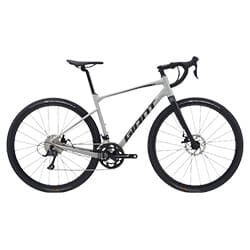
A great example of gravel balancing out the harshness of a road bike. This bike has some built in shock-absorption without harming a surefooted ride so your comfort levels go up.
The handlebar and seat post are designed to smooth out the bumps of all surfaces.
It comes from the world’s largest producer of frames by volume and is supported by a reliable Shimano groupset.
4. Folding Bikes
Folding bikes are becoming more popular for what are known as multi-modal journeys where you take more than one form of transportation. Their popularity is on the up and they can make all the difference for a commuter.
Their small wheels are great for acceleration which suits urban stop-starts at red traffic signals. This can be a stumbling block for longer commutes because of a perceived loss of stability. The steering ‘column’ is a little further away than other bikes which creates a different ‘feel’ for the steering which requires practice.
They fold up quickly and easily without protruding, greasy parts to annoy you or fellow commuters and increasingly visible on public transport. For those who struggle to find safe and adequate parking, they do fit under desks or should be stored in the workplace itself.
If your commute takes in both overground and underground rail, or (check with bus companies first) a Park + Ride stop, then a folding bike is ideal. They are most suited for road surfaces although mixed terrain models can be found. We look at folding electric bikes in more detail here – a new take on assisted riding.
Folding Bikes for Long-Distance Bike Commuting [PROS + CONS]
| PROS | CONS |
|---|---|
| Upright riding position | Hills are harder work – without electric assistance |
| Easy to store | Ride can be unstable until mastered |
| Practicality and flexibility – especially in urban environments | Can be expensive |
Best Folding Bikes for Long Distance Bike Commutes
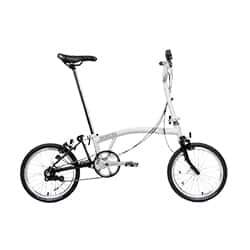
Brompton is the best-known folding-bike brand. They are well liked for their iconic award-winning design.
The quality of the build gives off elegance and the frame is as light and strong at this level.
After practice the folding process takes as little as 30 seconds, which is important if you’re doing this four times a day.
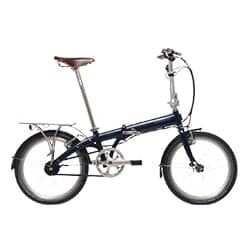
The Junction model in this range from the British manufacturer has slightly larger wheels at 20 inches.
This could increase stability on longer journeys and offer a more comfortable ride than with traditional 16 inch wheels of the genre.
The chain is on the inside of the folding mechanism which is going to help you and those around you on the busy concourse.
5. Electric Bikes
The electric bike is the ultimate aid to a long-distance commute. They are a boon to new commuters and leisure riders alike. They are increasingly common across Europe. As they become more popular, any stigma attached to riders ‘cheating’ is going to fall away. They appear to put a smile on the face of their owners.
In essence, you can receive electrical assistance via a motor – this assistance is immediately available when starting, or can be used to give a boost up hills. The top speed is limited by law. The boost is usually supplied via a button or lever on the handlebars. The batteries used to power the motor can be clipped off (in most cases) to be charged at your convenience. Most take less than a working day to recharge.
The range of the motor should be acceptable for all long commutes – depending upon the weight of the bike (we’ve looked at some here) anything from 42 – 128 miles between charges. We wouldn’t say that electric power should be on at all times – the assistance that they provide on hills or when riding into head winds is usually enough.
E-bikes are now available across the entire range of bicycle styles so they are true, go anywhere machines. We look at the best e-bike brands here. Their versatility is their strong point because of the assistance they offer.
E-Bikes for Long-Distance Bike Commuting [PROS + CONS]
| PROS | CONS |
|---|---|
| You can travel further | Cost to own |
| It takes less effort to travel the same distance as a mechanical bicycle | More attractive to thieves |
| Long term investment in reducing transport costs | Weight a challenge when riding unassisted for long periods |
Best E-Bikes for Long Distance Bike Commutes
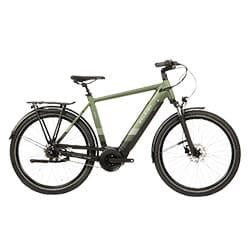
This impressive machine has a 128 mile range between charges so will not need regularly charging during a working week.
It has two types of ‘crossbar’ depending on your riding style and comes with mudguards, pannier racks and a kick stand.
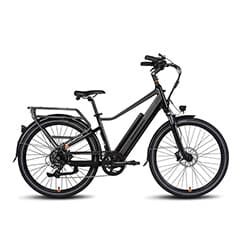
This manufacturer take a lot of the design cues from the well loved Dutch style of riding and has incorporated them into this design.
This means you get a great package of a comfortable, upright ride which is both elegant and makes you visible to other road users.
The motor provides an unconscious feeling of more power via a sensor and will give you an automatic boost.
Rear racks, mudguards / fenders and a kick-stand top off this very good looking machine. The range is expected to be 28 miles / 45 kilometres (minimum) between charges.
The post What’s the Best Bike for Long Distance Commuting? [5 PICKS] appeared first on Discerning Cyclist.